Source: BOMBSHELL: Study Proves Unvaccinated Children Are Healthier » Alex Jones’ Infowars: There’s a war on for your mind!
Source: Research: Unvaccinated Children Far Healthier, Have Fewer Disorders » Alex Jones’ Infowars: There’s a war on for your mind!
RESEARCH: UNVACCINATED CHILDREN FAR HEALTHIER, HAVE FEWER DISORDERS
Even more, the CDC has never bothered to perform study

IMAGE CREDITS: CARLOS REUSSER MONSALVEZ/FLICKR .
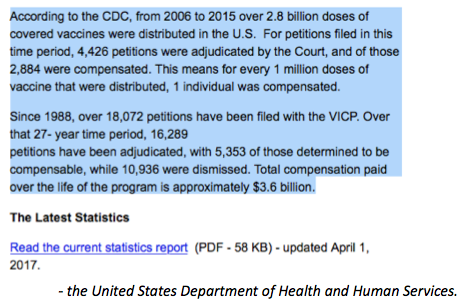
Conclusions: “These data suggest that there may be an increased incidence of certain cancers among the 98 million persons exposed to contaminated polio vaccine in the U.S.; further investigations are clearly justified.”Vaccination and Health Outcomes: A Survey of 6- to 12-year-old Vaccinated and Unvaccinated Children based on Mothers’ Reports. Front. Public Health (Frontiers in Public Health, November 2016)
According to Barbara Loe Fisher of the National Vaccine Information Center:
1 highly vaccinated child in 45 develops autism in America today;24 1 in 6 has learning disabilities; 25 1 in 9 has asthma;26 1 in 10 has ADHD;27 1 in 12 suffers with depression;28 ,29 1 in 400 become diabetic30 and millions more struggle with other kinds of immune and brain disorders marked by chronic inflammation in the brain and body.31,32, 33, 34
[youtube https://www.youtube.com/watch?v=Z5lTnJnsnrs?rel=0]
References:
24 Zabolotsky B, Black LI et al. Estimated Prevalence of Autism and Other Developmental Disabilities Following Questionnaire Changes in the 2014 National Health Interview Survey . CDC National Health Statistics Reports Nov. 13, 2015.
25 Boyle CA, Boulet S et al. Trends in the Prevalence of Developmental Disabilities in US Children 1997-2000. Pediatrics May 23, 2011.
26 Stoner Am, Anderson SE, Buckley JJ. Ambient Air Toxics and Asthma Prevalence among a Representative Sample of US Kindergarten-Age Children. PLOS One 2013; 8(9).
27 Kounang N.ADHD diagnoses rise to 11% of kids. CNN Nov.22, 2013
28 Substance Abuse and Mental Health Services Administration. Survey reveals adolescent females are twice as likely as adolescent males to suffer a major depressive episode . SAMHSA May 13, 2008.
29 National Alliance on Mental Illness. Anxiety Disorders in Children and Adolescents. May 2014.
30 American Diabetes Association.U.S. Diabetes Statistics: Under 20 Years of Age. American Diabetes Association Feb. 12, 2014.
31 Zimm A. Chronic Illnesses on rise, study says: Children’s cases in U.S. quadruple . Bloomberg News June 27, 2007.
32 American Autoimmune Related Diseases Association. Growing Number of Autoimmune Disease Cases Reported . AARDAPress Release June 21, 2012.
33 Jackson KD, Howie LD, Akinabami LJ. Trends in Allergic Conditions Among Children: United States, 1997-2011 . NCHS Databrief May 2013; 121.
34 Silverberg JI, Joks R, Durkin HG. Allergic disease is associated with epilepsy in childhood: a population based study .Allergy 2014; 69(10: 1428.
Note: In response to correspondence from a reader, this page was edited on 2/8/2015. Two references to broken links (now showing as “suspended page“) were removed. And, since the sample size of 94 compared to another sample size of over 13,000 cannot provide reliable data, we have removed commentary on the rate of infections and atopy in certain age groups.
Are health outcomes different when one compares vaccinated children with unvaccinated children? To date, there has never been an independent, adequately designed, prospective, randomized placebo-controlled study on this subject containing enough “n” (numbers of children) to have statistical significance.
In fact, this sort of study, that would give the most definitive answer (i.e., long-term total health outcome in the prospective randomized placebo-controlled trial of the whole vaccination schedule) is considered “unethical” by the establishment so only small, biased or “meta-analysis” studies are put in front of consumers. You can find this list of studies at the bottom of this article.
The following is taken in part from Public Testimony of Dr. Heather Rice at the Vermont Department of Health hearing on Act 157, 10/19/2012:
No true prospective, randomized and controlled study of health outcomes of vaccinated people versus unvaccinated has ever been conducted in the U.S. by CDC or any other agency in the 50 years or more of an accelerating schedule of vaccinations.
However, a German study published in 2011 compared the health outcomes of 94 unvaccinated children versus 13,359 vaccinated children (Dtsch Arztebl Int. 2011 February; 108(7): 99–104.”Vaccination Status and Health in Children and Adolescents; Findings of the German Health Interview and Examination Survey for Children and Adolescents (KiGGS).” (pdf of article – reply#1 – reply#2 – reply#3 ). Because the number of unvaccinated children included in the analysis is so small, statistical evaluation is nearly impossible.
Vaccination status and health in children and adolescents: findings of the German Health Interview and Examination Survey for Children and Adolescents (KiGGS).
Schmitz R1, Poethko-Müller C, Reiter S, Schlaud M.
Whether unvaccinated children and adolescents differ from those vaccinated in terms of health is subject to some discussion.
Method:
We evaluated data on diseases that are preventable by vaccination, infectious and atopic diseases, and vaccinations received that had been collected between 2003 and 2006 in a representative sample of 17 641 subjects aged 0 to 17 years in the framework of the German Health Interview and Examination Survey for Children and Adolescents (Kinder- und Jugendgesundheitssurvey, KiGGS).
Results:
Evaluable data on vaccinations were available for 13 453 subjects aged 1-17 years from non-immigrant families. 0.7% of them (95% confidence interval: 0.5%-0.9%) were not vaccinated. The lifetime prevalence of diseases preventable by vaccination was markedly higher in unvaccinated than in vaccinated subjects. Unvaccinated children aged 1-5 years had a median number of 3.3 (2.1-4.6) infectious diseases in the past year, compared to 4.2 (4.1-4.4) in vaccinated children. Among 11- to 17-year-olds, the corresponding figures were 1.9 (1.0-2.8) (unvaccinated) versus 2.2 (2.1-2.3) (vaccinated). The lifetime prevalence of at least one atopic disease among 1- to 5-year-olds was 12.6% (5.0%-28.3%) in unvaccinated children and 15.0% (13.6%-16.4%) in vaccinated children. In older children, atopy was more common, but its prevalence was not found to depend on vaccination status: among 6- to 10-year-olds, the prevalence figures were 30.1% (12.9%-55.8%) for unvaccinated children versus 24.4% (22.8%-26.0%) for vaccinated children, and the corresponding figures for 11- to 17-year-olds were 20.3% (10.1%-36.6%) versus 29.9% (28.4%-31.5%).
Conclusion:
The prevalence of allergic diseases and non-specific infections in children and adolescents was not found to depend on vaccination status.
- Correspondence (letter to the editor): Many questions remained unanswered. [Dtsch Arztebl Int. 2011]
- Correspondence (letter to the editor): The timing of the vaccination is important. [Dtsch Arztebl Int. 2011]
- PMID:
- 21412506
- [PubMed – indexed for MEDLINE]
- PMCID:
- PMC3057555
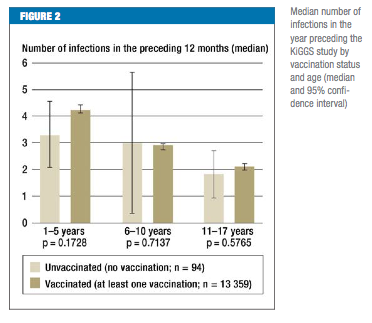 This study was based on data collected during the German Health Interview and Examination Survey for Children and Adolescents (KiGGS) and was conducted from May 2003 to May 2006 by the Robert Koch Institute. The objective of the interview and examination survey was to collect representative data on the health status of children and adolescents aged up to 17 years. In total, 17 641 children and adolescents (8656 girls, 8985 boys) and their parents participated in the study but only 13,453 (76%) were included in the presented, published analysis.
This study was based on data collected during the German Health Interview and Examination Survey for Children and Adolescents (KiGGS) and was conducted from May 2003 to May 2006 by the Robert Koch Institute. The objective of the interview and examination survey was to collect representative data on the health status of children and adolescents aged up to 17 years. In total, 17 641 children and adolescents (8656 girls, 8985 boys) and their parents participated in the study but only 13,453 (76%) were included in the presented, published analysis.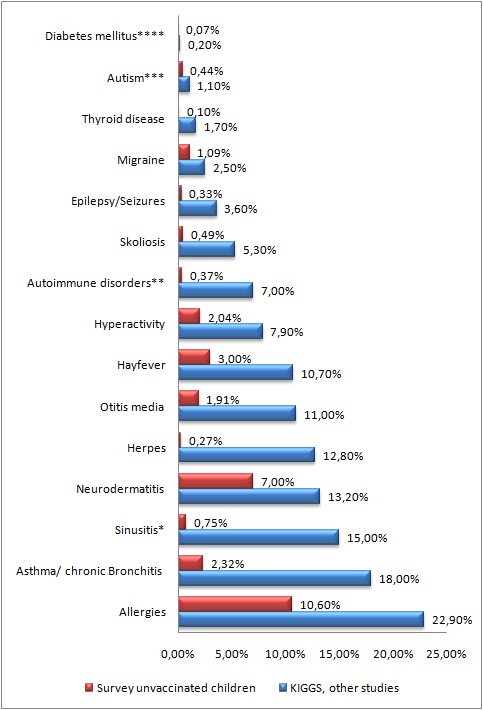
Additionally, there is an ongoing survey in Germany with currently 12,583 participants and the results of this survey show that unvaccinated children are far less affected by common diseases than vaccinated children.The results are presented in the bar chart below and complete data and survey results are linked here. The data is compared to the national German KIGGS health study of the children in the general population. Most of the respondents to the survey were from the U.S.A.
The data was collected from parents with vaccine-free children via an internet questionnaire by vaccineinjury.info and Andreas Bachmair, a German classical homeopathic practitioner. The independent study is self-funded and is not sponsored by a large “credible” non-profit or government health organization with political and financial conflicts of interest; hence Bachmair relies on Google ads and donations for revenue. Each one of the studied cases are actual cases with medical documentation. Three other studies had similar results according to Bachmair and are reported below.
Longterm Study in Guinea-Bissau (1 Kristensen I, Aaby P, Jensen H.:“Routine vaccinations and child survival: follow up study in Guinea-Bissau, West Africa”, BMJ 2000; 321: 1435–41)
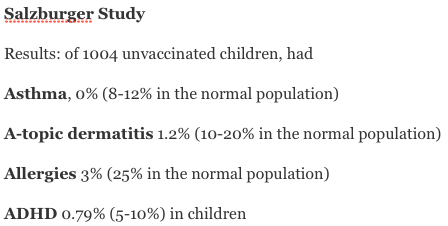
The children of 15,000 mothers were observed from 1990 to 1996 for 5 years.
Result: the death rate in vaccinated children against diphtheria, tetanus and whooping cough is twice as high as the unvaccinated children (10.5% versus 4.7%).
New Zealand Survey (1992) (http://www.ias.org.nz)
The study involved 254 children. In which 133 children were vaccinated and 121 remained unvaccinated.
Result:
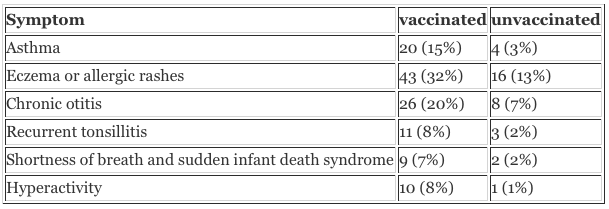
Another study by the Division of Pediatric Infectious Diseases, University of Louisville School of Medicine, Louisville, Kentucky used data from a previous Vaccine Safety Datalink study of thimerosal exposure looking at 42 neuropsychological outcomes and ran it through multivariable regression models which were specifically constructed to assess the impact of “timeliness” of vaccination (receipt within 30 days of recommended age) on neuropsychological outcomes after adjustment for potential confounders. The authors, Smith and Woods, controlled for cumulative ethylmercury exposure, without providing any explanation – even though ethylmercury would have been associated with receipt of 3 of the 4 vaccines in the analysis (hepatitis B, DPT and Hib). The authors concluded that, “timely vaccination during infancy has no adverse effect on neuropsychological outcomes 7 to 10 years later.” (link to article – link to reply letters)
Further Reading:
New Zealand Survey
Children vaccinated with DPT or MMR had 14 times more asthma and 9.4 times more eczema than non-vaccinated children. McKeever TM, Lewis SA, Smith C. Does vaccination increase the risk of developing allergic disease?: A birth cohort study. Winter Abstract supplement to Thorax. 2002;57: Supplement III.
The death rate in vaccinated children against diphtheria, tetanus and whooping cough was twice as high as the non-vaccinated children (10.5% versus 4.7%). Kristensen I, Aaby P, Jensen H. Routine vaccinations and child survival: follow up study in Guinea-Bissau, West Africa. British Medical Journal. 2000;321:1435-1441
The Nederlandse Vereniging Kritisch Prikken (Dutch Association for Conscientious Vaccination, The Netherlands) compared the health of vaccinated and non-vaccinated children using various categories (sickly, eczema, asthma/chronic lung disease, allergies, aggressive behavior, sleeping difficulty, ear infections, inflammation of the throat, convulsions/collapse, need for antibiotics) and in every category the non-vaccinated children’s parents reported a fraction of the incidence of these events than those of vaccinated children.
In a governmental hearing Philip Incao, MD reported what many other MDs have stated:
“In my medical career I’ve treated vaccinated and unvaccinated children and the unvaccinated children are far healthier than the vaccinated ones.”
- German study used by vaccine promoters to claim there is “lower rates of asthma among the vaccinated” http://www.jacionline.org/article/S0091-6749(13)01860-5/abstract
- Philippine study used by vaccine promoters to claim there are “cognitive benefits from vaccines” http://www.tandfonline.com/doi/abs/10.1080/00036846.2011.566203#.VM4Ni2TF8o
- “Studies” used by vaccine promoters to claim that “pregnant women who are vaccinated have better birth outcomes compared to non-vaccinated mothers:
- 2013 “meta-analysis” used by vaccine promoters to claim that “flu vaccine may lower the risk of heart attack” http://jama.jamanetwork.com/article.aspx?articleid=1758749
- “Study” used by vaccine promoters to claim that “vaccinated people are protected from the most serious effects of flu”: http://www.atsjournals.org/doi/abs/10.1164/rccm.201401-0066LE#.VSfg-ZSUcoa
